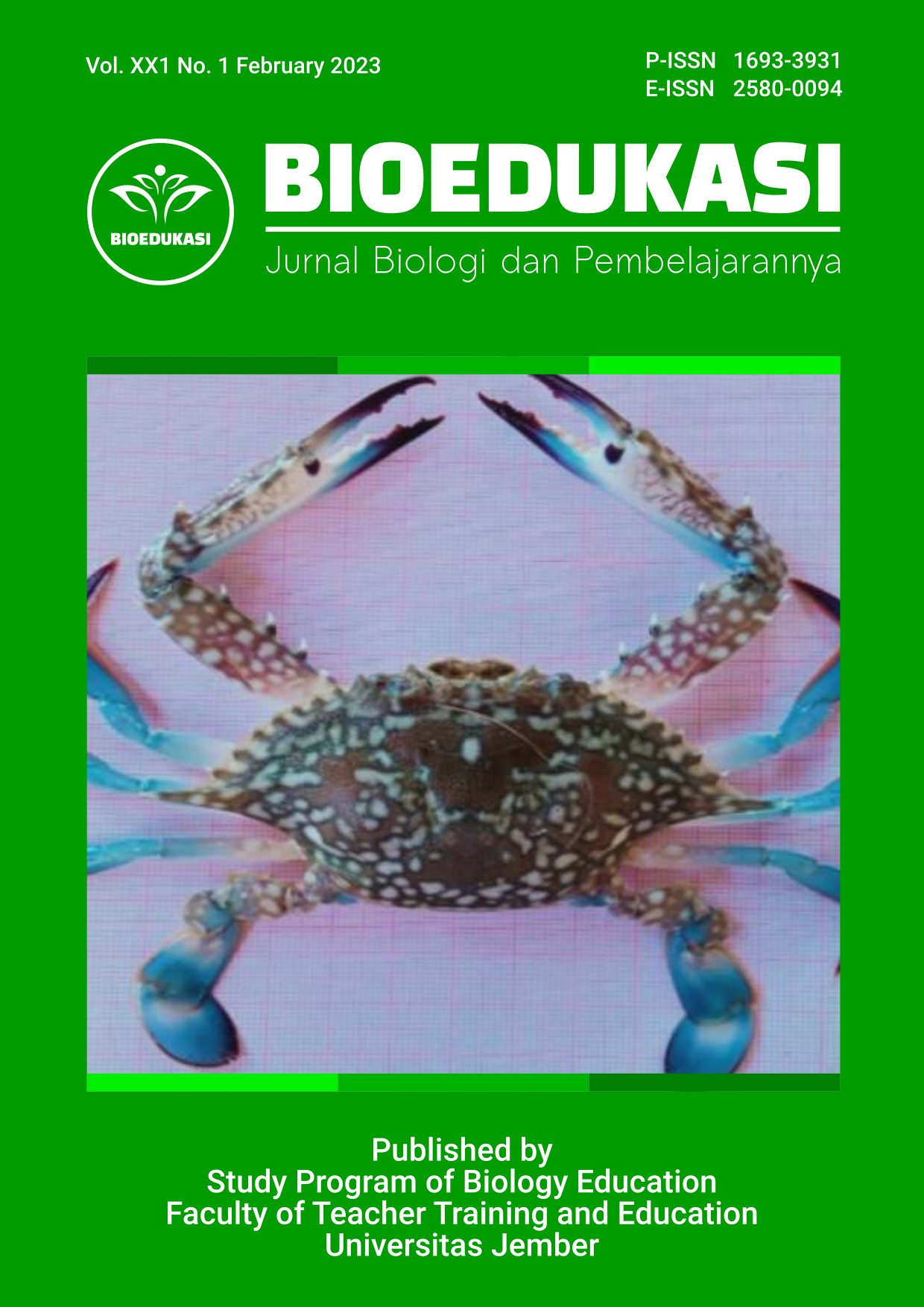Ethnomedicines Medicinal Plant In Pujon District, Malang Regency, East Java
DOI:
https://doi.org/10.19184/bioedu.v21i1.38023Keywords:
Etnomedicine, Homegarden, Traditional medicineAbstract
Traditional medicine is currently being abandoned by the community because its use is considered impractical and when it is taken in the form of medicine it tastes bad. Traditional medicine usually uses medicinal plants obtained from the surrounding environment. The community grows plants that are useful for daily life near the house, such as in the yard. Traditional medicine is one of the fastest ways to obtain the latest medicinal sources from plants that have been used by the community for generations. For this reason, research on ethnomedicine needs to be carried out. The people in Pujon District still practice traditional medicine to cure several diseases. A total of 47 species of plants in the garden are used as medicinal plants
Downloads
References
Aditama, T. Y. 2014. Jamu dan Kesehatan. Lembaga Penerbit Balitbangkes (LPB), Jakarta: ii+27 hlm
Amberber, M., M. Argaw & Z. Asfaw. 2014. The role of homegardens for in situ conservation of plant biodiversity in Holeta Town, Oromia National Regional State, Ethiopia. International Journal of Biodiversity and Conservation 6(1): 8—16.
Badan Pusat Statistik Kabupaten Malang. 2018. Kecamatan Pujon Dalam Angka 2018. Malang. Kurnia Offset. Ix+109 hlm.
Bajpai, S., A.K. Sharma & V.K. Kanungo. 2013. Traditional home gardens: A preserve of medicinal plants. International Journal of Herbal Medicine 1(2): 152—162.
Berihun, T. & E. Molla. 2017. Study on the Diversity and Use of Wild Edible Plants in Bullen District Northwest Ethiopia. Journal of Botany 2017: 1—10.
Carvalho, T.K.N., D.B. de Oliveira Abreu, C. M. de Lucena, K.M. Pedrosa, C.F.A. de Vasconcelos Neto, C.A.B. Alves, L.P. Félix, A.T.N. Florentino, R.R. da Nóbrega Alves, L.A. de Andrade & R.F.P. de Lucena. 2013. Structure and Floristics of Home Gardens in an Altitudinal Marsh in Northeastern Brazil. Ethnobotany Research & Applications 11: 29—48.
Departemen Kesehatan.1978. Surat Keputusan Menteri Kesehatan No.149/SK/Menkes/IV/1978 tentang Definisi Tanaman Obat.
Gbedomon, R.C., A.B. Fandohan, V.K. Salako, A.F.R. Idohou, R.G. Kakaї & A.E. Assogbadjo. 2015. Factors affecting home gardens ownership, diversity and structure: a case study from Benin. Journal of Ethnobiology and Ethnomedicine 11(56): 1—15.
Gurevitch, J., S. M. Scheiner & G.A. Fox. 2006. The ecology of plants. 2nd ed. Sinaeur Associated, Masachusetts: xvii+574 hlm.
Idohou, R., B. fandohan, V.K. Salako, B. Kassa, R.C. Gbèdomon, H. Yédomonhan, L.G. Kakaï & A.E. Assogbadjo. 2014. Biodiversity conservation in home gardens: traditional knowledge, use patterns and implications for manajemen. International Journal of Biodiversity Science, Ecosystem Services & Manajemen 10(2): 89—100.
Kehlenbeck, K. & B.L. Mass. 2004. Crop diversity and classification of homegardens in Central Sulawesi, Indonesia. Agroforestri System 63: 53—62.
Kurniawan, S., C. Prayogo, Widianto, M.T. Zulkarnain, n.D. Lestari, F.K. Aini & K. Hairiah. 2010. Estimasi Karbon Tersimpan di Lahan-lahan Pertanian di DAS Konto, Jawa Timur. World Agroforestri Centre. Bogor: vii+60 hlm.
Masadeh, M.A. 2012. Focus Group: Reviews and Practices. International Journal of Applied Science and Technology 2(10): 63—68.
Martin, G.J. 1995. Ethnobotany a methods manual. Springer. London: xxiv+268 hlm.
Mahunnah, R.L. 2002. Ethnobotany and conservation of medicinal plant in Africa: the way forward in the next decade. Dalam: Proceedings of 15th Meeting of the Inter-African Experts Committee on African Traditional Medicine and Medicinal Plants, Arusha, Tanzania, AU Lagos: 1—9.
Peres Gutierrez, R.M. 2011. Spasmolytic effect of constituents from ethnomedicinal plants on smooth muscle. Dalam Etnomedicinal plants: Revitalization of traditional knowledge of herbs. Editor Rai, M., D. Acharya & J.L. Rios. Science Publisher, Enfield: ix+497 hlm.
Ramawat, K.G. & J.M. Merillon. 2008. Bioactive molecules and medicinal plants. Springer. Verlag Berlin Heidelberg: xxiii+371 hlm.
Sari, I.D., Y. Yuniar, S. Siahaan, Riswati & M. Syaripuddin. 2015. Tradisi masyarakat dalam penanaman dan pemanfaatan tumbuhan obat di Pekarangan. Jurnal Kefarmasian Indonesia 5(2): 123—132.
Schmidt, B.M. & D.M. Klaser Cheng. 2017. Ethnobotany: A Phytochemical perspective, Part I introduction to ethnobotany and phytochemistry. Wiley-Blackwell John. United State America: xvii+376 hlm.
Silalahi, M. 2015. Kajian ekologi tumbuhan obat di agrofores desa Surung Mersada, kabupaten Phakpak Barat, Sumateras Utara. Jurnal Biologi 19(2): 89-94.
Sheil, D., R.K. Puri, I. Basuki, M. van Heist, M. Wan, N. Liswanti, Rukmiyati, M.A. Sardjono, I. Samsoedin, K. Sidiyasa, Chrisandini, E. Permana, E.M. Angi, F. Gatzweiler, B. Jhonson & A. Wijaya. 2004. Mengeksplorasi keanekaragaman hayati, lingkungan dan pandangan masyarakat lokal mengenai berbagai lanskap hutan. CIFOR, Bogor: x+101 hlm.
Young, K.J. 2007. Ethnobotany. Chelsea House Publishers. New York: vii+107 hlm.




 https://orcid.org/0000-0003-1920-0515
https://orcid.org/0000-0003-1920-0515